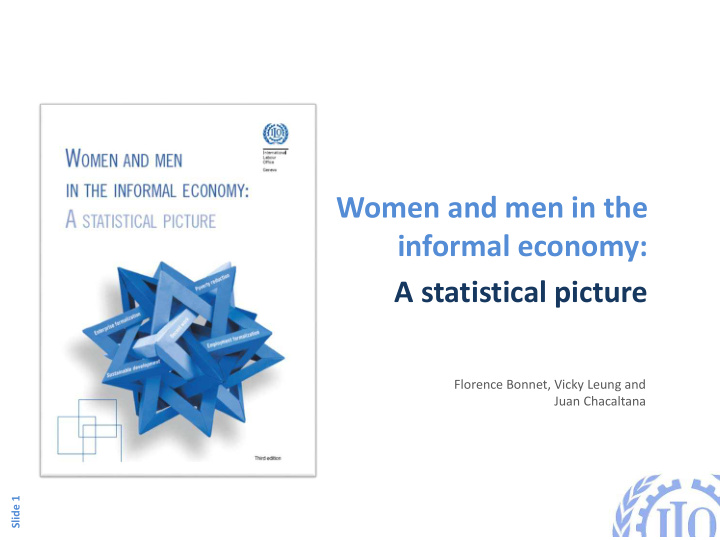



Women and men in the informal economy: A statistical picture Florence Bonnet, Vicky Leung and Juan Chacaltana Slide 1
Content An overview of the report in 4 questions Question 1 What is the size of the informal economy: global and regional dimensions? Question 2 Who are the most exposed to informality? Who are the most represented among those in informal employment? Question 3 Are decent work deficits most pronounced in the informal economy? Outline Question 4 What can we say about drivers of informality? Some first elements about a few of them… Slide 2
Question 1 What is the size of the informal economy: global and regional dimensions ? Slide 3
2 billion people — more than 60 per cent of the world’s employed population are in informal employment Informal employment Share of informal employment in total Formal employment employment (including & excluding agriculture, 2016) Developing World Developed Emerging Source : ILO calculations based on household survey micro datasets: Women and in the informal economy: a statistical picture Slide 4 Note: based on 119 countries representing more than 90 per cent of the world’s working population. Missing values are estimated based on sub-regional/ income groups averages.
The regional dimension of informality Share of informal employment in total employment (%, 2016) Source : ILO calculations based on household Slide 5 survey micro datasets (Women and in the informal economy: a statistical picture)
Question 2 Who are the most exposed to informality? Who are the most represented among those in informal employment? Slide 6
The gender dimension of informality Out of the two billion workers in informal employment, just more than 740 million are women 92.1 A proportion of contributing family workers 87.5 more than three times higher among women in 63.0 informal employment compared to men 1. Informal employment is a greater source of 58.1 employment for men (63%) than for women Distribution of people in informal employment by Developing (58%), but… employment status and sex (percentages, 2016) 2. … there actually more countries (55%) where World women are more exposed to informality than Developed men and … World 3. … women are more exposed than men to informal 69.1 64.2 employment in sub-Saharan Africa, Latin America or Southern Asia or more generally in low & lower-middle income countries Developing 18.9 Emerging Developed 17.6 Emerging 4. When women are in the informal economy, they are more often found in the most vulnerable situations than their male counterparts Slide 7
The self-employed are more exposed to informality … but employees are far from being exempted Share of informal employment & composition by employment status (%, 2016) Domestic workers Informal employment informally Informal employed in in the employment households: formal in the sector: 27% 5% informal sector: 2/3 OAW : Own-account workers CFW : Slide 8 Contributing family workers
The youth and older workers are the most likely to be in informal employment: more than 3 out of 4 are informally employed The age profile of informality: share of informal employment along the life course (%) by region by employment status — — OAW — — Total — — Employers — — Employees Slide 9 Source : ILO based on household surveys. Note : Global estimates based on 108 countries representing more than 85 per cent of total employment. Harmonized definition of informal employment.
Question 3 Are decent work deficits most pronounced in the informal economy ? R204 stresses the fact that decent work deficits are more pronounced in the informal economy, facts provide a confirmation Slide 10
Compared to permanent, full-time employment, non-standard forms of employment are significantly more likely to be informal , the worst situation being employees in “temporary part-time jobs” Share of informal employment and NSFEs (%, latest available year) Among employees Note: Global and regional estimates based on data for 96 countries representing over 78 per cent of the world employed population. Slide 11 Harmonized definition of informal employment and informal sector. Source: ILO calculation based on national labour force surveys or similar household survey data.
Question 4 What can we say about drivers of informality? Some first elements about a few of them… Slide 12
Higher levels of GDP per capita and growth are associated to lower levels of informality … but not strictly: countries with similar levels of GDP per capita are presenting very different levels of informality Share of informal employment and level of GDP per capita Slide 13 Note: The coefficient of determination R2=0.57. Source: ILO harmonized data on the share of informal employment in total employment and World Development Indicators 2017 for GDP per capita.
The level of education of workers is not a guarantee but an important asset to access formal employment Share of informal employment in total Distribution of informal and formal employment by level of education | World employment by level of education (%) and main regions Slide 14 Note: Global and regional estimates based on data for 107 countries representing 86 per cent of the world’s employed population.. Source: ILO calculation based on micro data.
Poverty: a cause and a consequence of informality Consequence: higher poverty rates among A cause: the poor face higher rates workers in informal employment of informal employment …. compared to workers in formal employment Slide 15 Source: ILO calculation based on micro data
Thank you Slide 16
Recommend
More recommend